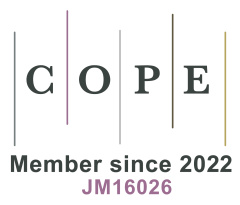Regulation mechanism and biomechanics effects of HER2 overexpression-related signalling pathway and targeted therapeutic strategy in breast cancer
Abstract
HER2 overexpression is an important pathogenic factor in breast cancer, affecting tumour proliferation and metastasis. In addition to molecular factors, the mechanical microenvironment within the tumour, including interstitial fluid pressure and shear stress, has been emerging as a significant regulator of cancer cell behavior. These mechanical forces can potentially interact with HER2-related signaling pathways, influencing the progression of breast cancer. The study investigated the regulatory mechanisms of HER2 overexpression-related signalling pathways and their targeted therapeutic effects in HER2-positive breast cancer patients receiving neoadjuvant therapy. Gene amplification and protein overexpression of HER2 were assessed by biomarker analysis, clinical data evaluation and survival analysis according to HER2 expression. The progression-free survival and overall survival of the experimental group (HER2-targeted therapy group and combination therapy group) were significantly better than that of the control group (chemotherapy-only group) after treatment, with PFS of 18.4 and 21.2 months, respectively, compared with 12.6 months in the control group (P < 0.05). Biomechanically, this indicates a more favorable response in terms of the mechanical stability and growth inhibition of tumors in the experimental groups. The level of HER2 receptor was significantly decreased in the experimental group after treatment (P < 0.01), and the cell-cycle analysis showed that the targeted cell cycle was stalled at G1 phase in the treatment group. This effectively inhibited the proliferation of breast cancer cells, potentially altering their mechanical interactions with the surrounding tissue. The activation level of HER2-related signalling pathway was significantly reduced in the targeted therapy group, and the expression of HER2 protein within the treatment group also showed a downward trend. These molecular alterations are likely to impact the biomechanical properties of the cells, such as their stiffness and motility. HER2-targeted therapy significantly improved the treatment effect of HER2-positive breast cancer patients by regulating the signalling pathways such as PI3K/Akt, RAS/MAPK and JAK-STAT. In the context of biomechanics, these pathways are involved in regulating cell-matrix interactions, cell-cell adhesion, and intracellular force generation. The combination therapy is superior to HER2-targeted therapy alone in improving the tumour shrinkage rate, which is of potential clinical value and provides a more precise therapeutic strategy and biomechanics basis for neoadjuvant treatment of HER2-positive breast cancer.
References
1. Roberto LG, Eric M, Jorge TKP. Artificial Intelligence-Enhanced Breast MRI: Applications in Breast Cancer Primary Treatment Response Assessment and Prediction. Investigative Radiology. 2024; 59(3): 230–242.
2. Huang P, Cheng H, Ji J, et al. LncRNA Miat knockdown enhances pirarubicin-mediated anticancer sensitivity in breast cancer cells. Environmental Toxicology.2024; 9(1): 3–30.
3. Shi Q, Huang F, Wang YG. HER2 phosphorylation induced by TGF-β promotes mammary morphogenesis and breast cancer progression. The Journal of Cell Biology. 2024; (4): 2–19.
4. Serrano JM, Gonzalez, I, Del Castillo S, et al. Diastolic Dysfunction Following Anthracycline-Based Chemotherapy in Breast Cancer Patients: Incidence and Predictors. International Journal of Cardiology. 2023; 382(1): 52–59.
5. Chumsri S. Advancing outcomes of metastatic HER2-positive breast cancer. The Lancet. 2023; 401(10390): 1746–1747.
6. Kasi A, Phadnis MA, Al-Rajabi RMT, et al. A phase II open-label study of enfortumab vedotin in patients with previously treated locally advanced, recurrent, or metastatic pancreatic adenocarcinoma (EPIC). Journal of Clinical Oncology. 2024; 42(3): 719–720.
7. You D, Kim H, Jeong Y, et al. Chemokine (C-C motif) Ligand 2 Is Regulated Through the EGFR/Src Pathway in HER2-positive Breast Cancer Cells. AntiCancer Research. 2023; 43(3): 1079–1089.
8. Atallah NM, Alsaleem M, Toss MS, et al. Differential response of HER2-positive breast cancer to anti-HER2 therapy based on HER2 protein expression level. British Journal of Cancer. 2023; 129(10): 2–14.
9. Aidt F, Sierra M, Salomon K, et al. Comparing the Sensitivity of HER2 Epitope Detection of HercepTest mAb pharmDx (Dako Omnis, GE001) and Ventana PATHWAY Anti-HER-2/neu (4B5) Using IHC Calibrators. Applied Immunohistochemistry & Molecular Morphology. 2024; 32(10): 469–475.
10. Wolff AC, Somerfield MR, Dowsett M, et al. Human Epidermal Growth Factor Receptor 2 Testing in Breast Cancer: ASCO-College of American Pathologists Guideline Update. Journal of Clinical Oncology. 2023; 41(22): 3867–3872.
11. Adsul S, Oberai P, Jones S. S1341Proactive Patient Engagement to Optimize the VICTRIVA Trial Protocol for Dual Targeted Therapy with Vedolizumab and Upadacitinib in Patients with Crohn’s Disease. The American Journal of Gastroenterology. 2024; 119(10): 960–961.
12. Mueller JA, Vordermark D. Importance of “targeted therapy” in EGFR-mutated Lung Cancer after Radiochemotherapy. Strahlentherapie und Onkologie. 2024; 200(10): 921–923.
13. Church AJ, Corson LB, Pei-Chi K, et al. Molecular profiling identifies targeted therapy opportunities in pediatric solid cancer. Nature Medicine. 2024; 28(8): 1581–1589.
14. Schonck WAM, Stroes ESG, Hovingh GK, et al. Long-Term Efficacy and Tolerability of PCSK9 Targeted Therapy: A Review of the Literature. Drugs. 2024; 84(2): 165–178.
15. Wang S, Wang Y, Lai X, et al. Minimalist Nanocomplex with Dual Regulation of Endothelial Function and Inflammation for Targeted Therapy of Inflammatory Vascular Diseases. ACS Nano. 2023; 17(3): 2761–2781.
Copyright (c) 2025 Author(s)

This work is licensed under a Creative Commons Attribution 4.0 International License.
Copyright on all articles published in this journal is retained by the author(s), while the author(s) grant the publisher as the original publisher to publish the article.
Articles published in this journal are licensed under a Creative Commons Attribution 4.0 International, which means they can be shared, adapted and distributed provided that the original published version is cited.



 Submit a Paper
Submit a Paper
